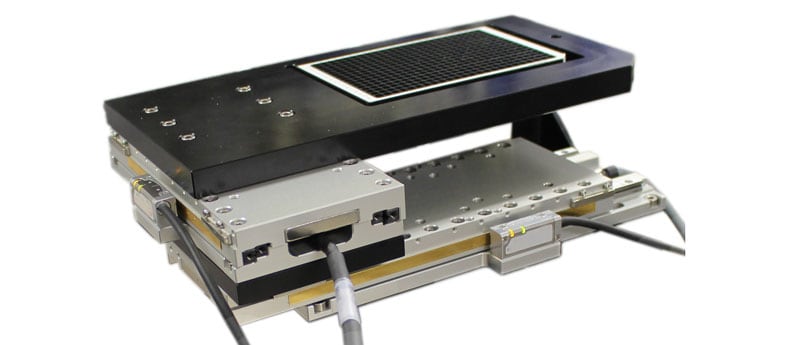
Servo Motors
DOVER servo motors are available in rotary brushed, rotary brushless, and linear brushless models.
The servo motor amplifiers to drive these motors can be categorized by their output stage type (Linear or Pulse Width Modulated), and the method of commutation (brushes, digital Halls, analog Halls, or encoder-based). The standard input to a servo motor amplifier is a single analog voltage, which typically can vary from +10 volts to -10 volts. While amplifiers can be configured as either voltage or current output, we only employ current mode amplifiers; in this case, an input voltage commands an output current. Operation in this mode provides less undesirable phase shift in the servo loop, and makes the amplifier less sensitive to changes in motor inductance.
Amplifiers with a linear output stage have certain advantages, but must be carefully matched to the application. They have none of the electrical noise associated with PWM amplifiers, making them ideal candidates for noise sensitive applications. They can also provide very low errors as they cross through zero current. Their primary disadvantage is that they are quite limited in power, since the linear output stage is inefficient. In addition, care must be taken to avoid secondary breakdown, by remaining within the Safe Operating Area at all times. Accordingly, linear amplifiers are best suited to low power applications which can benefit from low zero-crossing errors and noise.
With PWM output stages, the output switches between full positive and full negative at ~20 kHz, and the duty cycle is varied to produce the desired average current. This technique is very efficient, and hence much higher electrical power is available in a compact, easy to cool amplifier. Since any polyphase motor must be commutated (coils energized alternately to maintain uniform torque or force) the method of commutation further differentiates servo amplifiers. Brush motors are self-commutating, and from the perspective of the amplifier, only a single two-wire coil is being driven. DOVER brushless motors are three phase motors, with three coils wound in a delta (triangular) fashion. Our BDM6 servo amplifier accepts three digital Hall-effect sensors, which are mounted on the motor and sense coil position. It includes three half bridges, which drive the three phases. By the simple expedient of jumpering the Hall input lines to particular states, this brushless amplifier can now drive a brush type motor.
The small force irregularities that result from discrete switching of the motor coils in linear motor systems can be undesirable. Analogous to the microstepping of step motors, sinusoidal commutation replaces discrete coil switching with smooth, sinusoidally varying coil currents. There are two techniques to achieve this. In one, the three digital Hall sensors are replaced with two analog Hall devices, which sense both the magnetic field polarity and strength. The single servo amplifier input signal is multiplied by these two signals, and the resulting two signals command a specialized amplifier. This technique conserves DAC outputs, and requires no phase finding routine upon power-up. The other technique eliminates the analog multiplication, and relies on the controller to calculate the commutation signal values, based on the position of the linear encoder. While potentially more accurate, this technique requires more computational resources in the controller, uses two DAC outputs per axis, and requires a phase finding routine upon power-up.

